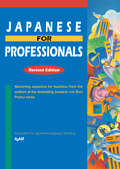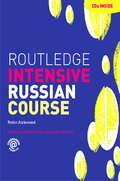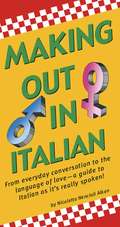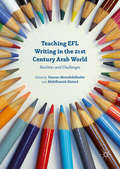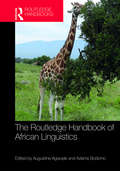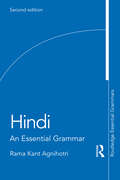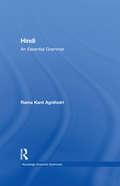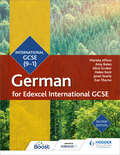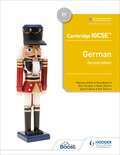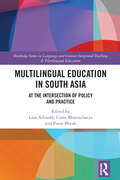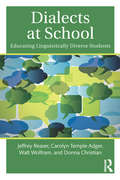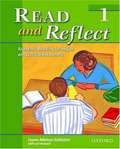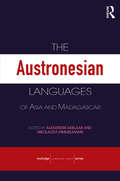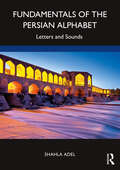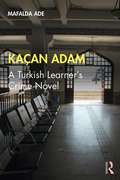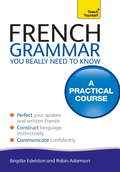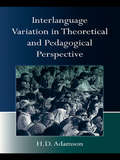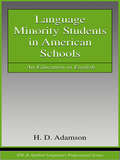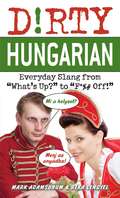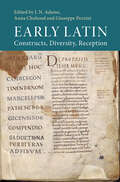- Table View
- List View
Japanese for Professionals: Mastering Japanese for business from the authors of the bestselling JAPANESE FOR BUSY PEOPLE series
by AJALTFrom the authors of the best-selling Japanese for Busy People series comes a must have for intermediate and advanced learners who want to focus on building business Japanese language skills.The Association for Japanese-Language Teaching (AJALT), renowned for its Japanese for Busy People series, has developed a comprehensive course for students who need to use Japanese in a real-life business environment.Almost a decade after its first edition, Japanese for Professionals has been revised and updated to reflect current business scenes. Moreover, learners can now practice their listening skills with the newly added audio for the dialogues and exercises from the text.Eight lessons introduce common business situations with the emphasis on how to communicate with Japanese colleagues and clients. Each lesson is consisted with two parts: Part 1 is set to observe the dialogue and Part 2 is set to further enhance comprehension of the dialogue with exercises.Precise definitions for all new vocabulary and lucid explanations of grammar, idioms, and cultural differences provide the reader with powerful communication tools for the office. Exercises and quizzes have been included to help students check their progress. Busy professionals will find the bilingual glossaries a useful reference even after completing all the lessons in this clear and extremely helpful textbook.Japanese for Professionals is specially designed for learners who are familiar with basic Japanese and ideally be at level N2 or N3 of JLPT, Japanese-Language Proficiency Test.
Routledge Intensive Russian Course (Routledge Intensive Language Courses)
by Robin AizlewoodThis intensive foundation course in Russian is designed for students with no previous knowledge of the language. Developed primarily for classroom use, the course offers an original and distinctive approach to language learning, presenting Russian in context offering access to Russian life, culture, history and society. Using authentic language throughout, the course takes students from beginner to intermediate level in one year. Progress is carefully structured, starting with simple grammar and working towards more complex points with the acquisition of a significant body of vocabulary. By the end of the course students will have acquired a sound knowledge of the main structures of the language and will be able to express themselves confidently in a wide range of communicative contexts. The tried-and-tested material featured in the course is structured to improve all four core skills of language learning: speaking, listening, reading and writing. The course is divided in three parts: Part 1 provides a foundation which gets the student going in Russian Part 2 concentrates on intensive development to take the student rapidly forward Part 3 incorporates both revision and further development. Each unit is divided into lessons which all include lively dialogues, sections on grammar and language functions and lots of exercises that help develop the student's practical language skills. Audio materials recorded by native speakers include dialogues, exercises and a variety of texts to help students using the course to improve their listening comprehension and pronunciation skills. Audio materials recorded by native speakers include dialogues, exercises and a variety of texts to help students using the course to improve their listening comprehension and pronunciation skills. The audio materials and other supplementary materials are available as free eResources here: www.routledge.com/9780415223003.
Making Out In Italian: (Italian Phrasebook)
by Nicoletta Nencioli AikenMaking Out in Italian is a fun, accessible and thorough Italian phrase book and guide to the Italian language as it's really spoken.This friendly and easy-to-use Italian phrasebook makes this possible.<P><P> Making Out in Italian has been carefully designed to act as a guide to modern colloquial Italian for use in everyday informal interactions-giving access to the sort of catchy Italian expressions that aren't covered in traditional language materials. Each expression is given in Italian so that in the case of difficulties the book can be shown to the person the user is trying to communicate with. In addition, phonetic spellings of all words and phrases are included, making speaking Italian a breeze. For example, "Hi!"-ciao is also written as chah-oh.This Italian phrasebook includes:A guide to pronouncing Italian words correctly including double consonants and syllable stressesExplanations of basic Italian grammar, such as, questions, word gender, and formal vs. informalComplete Italian translations for all words and phrases including easy-to-use phonetic spellings.Useful and interesting notes on Italian language and cultureLots of colorful, fun and useful expressions not covered in other phrasebooks
Sendas literarias 1
by Aída Walqui-Van Lier Ruth A. Barraza Mary Ann DellingerThis highly praised two-level literature and language series taps the natural potential of heritage learners, building their listening, speaking, reading, and writing skills as it celebrates and validates their rich cultural heritage. The varied learning strategies, study skills, and activities are specifically designed to meet the diverse needs and ability levels of native Spanish speakers.
Teaching EFL Writing in the 21st Century Arab World
by Abdelhamid Ahmed Hassan AbouabdelkaderTeaching EFL Writing in the 21st Century Arab World addresses a range of issues related to researching and teaching EFL writing in different countries in the Arab World including Egypt, Morocco, Oman, Palestine, Tunisia, UAE and Yemen. Both theoretically and practically grounded, chapters within discuss the different contexts in which EFL writing is taught, from primary school to university. The book sheds light on how EFL writing is learned and taught at each educational stage, exposing the different challenges encountered in the teaching and learning. The focus on EFL writing in the Arab World makes this a unique and long overdue contribution to the field of research around EFL writing and will be an invaluable resource for researchers, curriculum designers and students.
The Routledge Handbook of African Linguistics (Routledge Language Handbooks)
by Augustine Agwuele Adams BodomoThe Handbook of African Linguistics provides a holistic coverage of the key themes, subfields, approaches and practical application to the vast areas subsumable under African linguistics that will serve researchers working across the wide continuum in the field. Established and emerging scholars of African languages who are active and current in their fields are brought together, each making use of data from a linguistic group in Africa to explicate a chosen theme within their area of expertise, and illustrate the practice of the discipline in the continent.
Hindi: An Essential Grammar (Routledge Essential Grammars)
by Rama Kant AgnihotriHindi: An Essential Grammar is a practical reference guide to the core structures and features of modern Hindi. Assuming no prior knowledge of Hindi grammar, this book avoids jargon and overly technical language as it takes the student through the complexities of Hindi grammar in short, readable sections. Suitable for either independent study or for students in schools, colleges, universities and adult education classes, key features include: Full examples throughout in both Devanagari and Roman script with a gloss in English Glossary of technical terms and detailed subject index Cross referencing between sections Authentic material provided in the appendix demonstrating grammar usage Hindi: An Essential Grammar will help students, in both formal and non-formal education and of all levels to read, speak and write the language with greater confidence and accuracy. The revised edition rectifies the printing errors inadvertently made in the first edition; it also further clarifies several other issues including Hindi word order flexibility, compound nouns, ergativity, pronominal usage and polite communication.
Hindi: An Essential Grammar (Routledge Essential Grammars)
by Rama Kant AgnihotriThis text provides a reader-friendly guide to the structural patterns of modern standard Hindi. Ideal for both independent learners and classroom students alike, this book covers the essentials of Hindi grammar in readable, jargon-free sections. Key features include: sections on the speech sounds of Hindi detailed analysis of Hindi sentence structure full examples throughout.
Edexcel International GCSE German Student Book Second Edition
by Mariela Affum Amy Bates Alice Gruber Helen Kent Janet Searle Zoe Thorne Jean-Claude GillesThis Student Book provides a grammar-led approach with extensive exam preparation to develop independent, culturally aware students of German, ready for the exam.This book is endorsed by Cambridge International Examinations for the latest IGCSE® (0525) and International Level 1/Level 2 Certificate (0677) syllabuses. Extensive use of German reflects the style of the exams and, with specific advice and practice, it helps students use the acquired skills to their best ability. Topics on German-speaking cultures are integrated throughout to ensure students gain the cultural awareness that is at the heart of this qualification.- Develop students' ability to use German effectively - Stretch and challenge students to achieve their best grades - Ensure the progression required for further study at A-level or equivalent - Provide insight and encourage a positive attitude towards other culturesThe book provides up-to-date content following a clear sequencing of topics designed specifically for teaching German at this level. It is designed to develop spontaneous, confident linguists who are able to progress to further study of German.- Teacher Resource + Audio-CDs (ISBN 9781471833076) includes all recordings and transcripts together with detailed guidance, editable vocabulary lists, cultural PowerPoints and interactive quizzes- Grammar Workbook (ISBN 9781471833182)Vocabulary is also available online at Vocab Express, an interactive learning applicationVisit www.vocabexpress.co.uk/hodder for more information.
Cambridge IGCSE™ German Student Book Second Edition
by Mariela Affum Amy Bates Alice Gruber Helen Kent Janet Searle Zoe ThorneThis title is endorsed by Cambridge Assessment International Education to support the full syllabus for examination from 2021.Strengthen language skills and cultural awareness with a differentiated approach that offers comprehensive coverage of the revised Cambridge IGCSE™ German (0525/7159) syllabuses for first examination from 2021.- Develop the cultural awareness at the heart of the syllabus with engaging stimulus material and questions from around the world which will encourage a positive attitude towards other cultures- Progress the ability to use the language effectively with activities developing all four key skills, supported by teacher notes and answers in the teacher guide- Stretch and challenge students to achieve their best, whilst supporting all abilities with differentiated content throughout- Ensure the progression required for further study at A-level or equivalent- Help to prepare for the examination with exam-style questions throughoutAudio is available via the Boost eBook, Boost subscription or the Teacher Guide.Also available in the seriesReading and Listening Skills Workbook ISBN: 9781398329423Grammar Workbook ISBN: 9781510448056 Vocabulary Workbook ISBN: 9781510448063 Study and Revision Guide ISBN: 9781510448186 Boost eBook: 9781398329591Boost digital teacher resources ISBN: 9781398329546Teacher Guide with audio ISBN: 9781510448544
The Acquisition of Creole Languages
by Dany AdoneHow do children acquire a Creole as their first language? This relatively underexplored question is the starting point for this first book of its kind; it also asks how first language acquisition of a Creole differs from that of a non-Creole language. Dany Adone reveals that in the absence of a conventional language model, Creole children acquire language and go beyond the input they receive. This study discusses the role of input, a hotly debated issue in the field of first language acquisition, and provides support for the nativist approach in the debate between nativism and input-based models. The Acquisition of Creole Languages will be essential reading for those in the fields of first language acquisition and Creole studies. Adone takes an interdisciplinary approach, using insights from non-verbal language acquisition, which makes this of great interest to those in the field of sign linguistics.
Multilingual Education in South Asia: At the Intersection of Policy and Practice (Routledge Series in Language and Content Integrated Teaching & Plurilingual Education)
by Lina Adinolfi Usree Bhattacharya Prem PhyakSpanning scholarly contributions from India, Nepal, Bangladesh, Pakistan, and Sri Lanka, this edited volume seeks to capture and elucidate the distinct challenges, approaches and possible solutions associated with interpreting, adapting and applying language-in-education policies in a range of linguistically complex teaching and learning environments across South Asia. Centring on-the-ground perspectives of scholars, practitioners, pupils, parents and the larger community, the volume offers new insights into one of the most complex, populous, and diverse multilingual educational contexts in the world. Language-in-education policies and practices within this setting represent particularly high stakes issues, playing a pivotal role in determining access to literacy, thereby forming a critical pivot in the reproduction of educational inequality. The broad aim of the collection is thus to highlight the pedagogical, practical, ideological and identity-related implications arising from current language-in-education policies in this region, with the aim of illustrating how systemic inequality is intertwined with such policies and their associated interpretations. Aimed at both academics and practitioners - whether researchers and students in the fields of education, linguistics, sociology, anthropology or South Asian studies, on the one hand, or language policy advisors, curriculum developers, teacher educators, teachers, and members of funding bodies, aid providers or NGOs, on the other - it is anticipated that the accounts in this volume will offer their readership opportunities to consider their wider implications and applications across other rich multilingual settings – be these local, regional, national or global.
Dialects at School: Educating Linguistically Diverse Students
by Carolyn Temple Adger Donna Christian Jeffrey Reaser Walt WolframLike its predecessor, Dialects in Schools and Communities, this book illuminates major language-related issues that educational practitioners confront, such as responding to dialect related features in students’ speech and writing, teaching Standard English, teaching students about dialects, and distinguishing dialect difference from language disorders. It approaches these issues from a practical perspective rooted in sociolinguistic research, with a focus on the research base for accommodating dialect differences in schools. Expanded coverage includes research on teaching and learning and attention to English language learners. All chapters include essential information about language variation, language attitudes, and principles of handling dialect differences in schools; classroom-based samples illustrating the application of these principles; and an annotated resources list for further reading. The text is supported by a Companion Website (www.routledge.com/cw/Reaser) providing additional resources including activities, discussion questions, and audio/visual enhancements that illustrate important information and/or pedagogical approaches. Comprehensive and authoritative, Dialects at School reflects both the relevant research bases in linguistics and education and educational practices concerning language variation. The problems and examples included are authentic, coming from the authors’ own research, observations and interactions in public school classrooms, and feedback in workshops. Highlights include chapters on oral language and reading and writing in dialectally diverse classrooms, as well as a chapter on language awareness for students, offering a clear and compelling overview of how teachers can inspire students to learn more about language variation, including their own community language patterns. An inventory of dialect features in the Appendix organizes and expands on the structural descriptions presented in the chapters.
Read and Reflect 1: Academic Reading Strategies and Cultural Awareness
by Jayme Adelson-Goldstein Lori HowardThis book is ideal for young adults planning to pursue a college education; however, it can also be used by students who want to improve their reading skills to attain a personal goal or to advance in the workplace.
The Austronesian Languages of Asia and Madagascar (Routledge Language Family Ser. #Vol. 7)
by Alexander Adelaar Nikolaus P. HimmelmannSome 800 Austronesian languages are spoken in the area extending from Madagascar to eastern Indonesia and to the north to Taiwan and the Philippines. They vary greatly in almost every possible respect, including the size and social make-up of the speech communities and their typological profiles. This book is designed to serve as a reference work a
Fundamentals of the Persian Alphabet: Letters and Sounds
by Shahla AdelFundamentals of the Persian Alphabet introduces complete beginners to the letters and sounds of Persian through pronunciation, basic vocabulary and phrases, conversation, and Persian culture. Students are also introduced to the distinction between the formal and informal forms of the language. As knowledge of letter–sound correspondence and phonological awareness is key to language learning, this textbook ensures learners start their learning journey with a strong foundation. This book is divided into six lessons presenting the modern Persian alphabet in groups of mostly similarly shaped letters that will allow learners to begin blending letters and segmenting words as soon as possible to make learning easier. With the guidance of additional audio and video resources, a comprehensive Persian–English glossary, and listening, speaking, reading, and writing exercises throughout the book, students will acquire the fundamental skills and knowledge for furthering their learning of the language. The ideal starting point for beginners, Fundamentals of the Persian Alphabet is designed for learners with very little or no previous knowledge of the language and is suitable for both independent and class-based study.
Kaçan Adam: A Turkish Learner’s Crime Novel
by Mafalda AdeAimed at intermediate Turkish learners, Kaçan Adam: A Turkish Learner’s Crime Novel is a short mystery / detective story in idiomatic Turkish complete with exercises, vocabulary and grammar review. Over the course of 24 lively chapters, it follows the fate of former intelligence officer Erkan Demirel, who has been convicted of selling secret military documents but who manages to escape from prison and embarks on a quest to prove his innocence… For use either as a supplement to classroom instruction (CEFR A2-B1 and ACTFL, Lower Intermediate Level) or individually, this book will guide students through their first complete novel in Turkish while revising and reinforcing key points of modern Turkish grammar and expression.
French Grammar You Really Need To Know: Teach Yourself
by Robin AdamsonComprehensive and clear explanations of key grammar patterns and structures are reinforced and contextualized through authentic materials. You will not only learn how to construct grammar correctly, but when and where to use it so you sound natural and appropriate. French Grammar You Really Need to Know will help you gain the intuition you need to become a confident communicator in your new language.
French Grammar You Really Need To Know: Teach Yourself
by Robin AdamsonComprehensive and clear explanations of key grammar patterns and structures are reinforced and contextualized through authentic materials. You will not only learn how to construct grammar correctly, but when and where to use it so you sound natural and appropriate. French Grammar You Really Need to Know will help you gain the intuition you need to become a confident communicator in your new language.
Interlanguage Variation in Theoretical and Pedagogical Perspective
by H.D. AdamsonIn this book H.D. Adamson reviews scholarship in sociolinguistics and second language acquisition, comparing theories of variation in first and second-language speech, with special attention to the psychological underpinnings of variation theory. Interlanguage is what second language learners speak. It contains syntactic, morphological and phonological patterns that are not those of either the first or the second language, and which can be analyzed using the principles and techniques of variation theory. Interlanguage Variation in Theoretical and Pedagogical Perspective: relates the emerging field of variation in second language learners’ speech (interlanguage) to the established field of variation in native speakers’ speech relates the theory of linguistic variation with psycholinguistic models of language processing relates sociolinguistic variation theory to the theory of Cognitive Grammar suggests teaching applications that follow from the theoretical discussion At the forefront of scholarship in the fields of interlanguage and variation theory scholarship, this book is directed to graduate students and researchers in applied English linguistics and second language acquisition, especially those with a background in sociolinguistics.
Language Minority Students in American Schools: An Education in English (ESL & Applied Linguistics Professional Series)
by H. D. AdamsonThis book addresses questions of language education in the United States, focusing on how to teach the 3.5 million students in American public schools who do not speak English as a native language. These students are at the center of a national debate about the right relationship among ESL, bilingual, and mainstream classes. Bilingual education has been banned by constitutional amendment in California and Arizona, and similar amendments are being considered in other states. Language Minority Students in American Schools: An Education in English places this debate and related issues of teaching standard English to speakers of nonstandard dialects, such as black English, within the larger context of language acquisition theory and current methods of language teaching. Adamson draws from the large body of sociolinguistic, psycholinguistic, and educational research, and on his own experience as an English teacher in the U.S. and overseas, to shed light on some of these controversies and on the cognitive, cultural, public policy, and practical issues involved in educating English language learners. Presenting all sides of the issues fairly, he offers a strong endorsement for bilingual and bidialectical education based on programs designed and administered according to the principles discussed in the book and supported by language acquisition theory and classroom research. A strength of the book is the inclusion of original research conducted in a middle school enrolling a majority of Latino students. This research contributes to the field of language education by providing a detailed description of how English language learners study content subjects. Examples from the study are used to illustrate a discussion of Vygotskian learning principles and the relationship between the students' home and school cultures. Language Minority Students in American Schools: An Education in English is intended for students who are preparing to become teachers of English as a second language, and for teachers of other subjects who work with English language learners.
Dirty Hungarian: Everyday Slang from "What's Up?" to "F*%# Off!" (Dirty Everyday Slang Ser.)
by Mark Adamsbaum Réka LengyelGET D!RTY!Next time you're in Hungary or just chattin' in Hungarian with your friends, drop the textbook formality and bust out with expressions they never teach you in school, including:* cool slang* funny insults* explicit sex terms* raw swear wordsDirty Hungarian teaches the casual expressions heard every day on the streets of Hungary:What's up? Mi a helyzet? Your boyfriend is hot shit. Állat jó pasi a barátod. Dude, I'm so wasted. Öcsém, ugy betintáztam.I gotta take a dump. Mennem kell szarni. Go fuck yourself! Menj a halál faszára! Can I get a blowey? Lecidázol? I'd love to hit that. Szeretném megdöngölni.
An Anthology of Informal Latin, 200 BC – AD 900
by Adams J. n.This book contains over fifty passages of Latin from 200 BC to AD 900, each with translation and linguistic commentary. It is not intended as an elementary reader (though suitable for university courses), but as an illustrative history of Latin covering more than a millennium, with almost every century represented. Conventional histories cite constructions out of context, whereas this work gives a sense of the period, genre, stylistic aims and idiosyncrasies of specific passages. 'Informal' texts, particularly if they portray talk, reflect linguistic variety and change better than texts adhering to classicising norms. Some of the texts are recent discoveries or little known. Writing tablets are well represented, as are literary and technical texts down to the early medieval period, when striking changes appear. The commentaries identify innovations, discontinuities and phenomena of long duration. Readers will learn much about the diversity and development of Latin.
Early and Late Latin
by James Adams Nigel Vincent Valerie KnightThis book addresses the question of whether there are continuities in Latin spanning the period from the early Republic through to the Romance languages. It is often maintained that various usages admitted by early comedy were rejected later by the literary language but continued in speech, to resurface centuries later in the written record (and in Romance). Are certain similarities between early and late Latin all that they seem, or might they be superficial, reflecting different phenomena at different periods? Most of the chapters, on numerous syntactic and other topics and using different methodologies, have a long chronological range. All attempt to identify patterns of change that might undermine any theory of submerged continuity. The patterns found are summarised in a concluding chapter. The volume addresses classicists with an interest in any of the different periods of Latin, and Romance linguists.
Early Latin: Constructs, Diversity, Reception
by J. N. Adams Anna Chahoud Giuseppe Pezzini Charlie KerriganThis is the most detailed and comprehensive study to date of early Latin language, literary and non-literary, featuring twenty-nine chapters by an international team of scholars. 'Early Latin' is interpreted liberally as extending from the period of early inscriptions through to the first quarter of the first century BC. Classical Latin features significantly in the volume, although in a restricted sense. In the classical period there were writers who imitated the Latin of an earlier age, and there were also interpreters of early Latin. Later authors and views on early Latin language are also examined as some of these are relevant to the establishment of the text of earlier writers. A major aim of the book is to define linguistic features of different literary genres, and to address problems such as the limits of periodisation and the definition of the very concept of 'early Latin'.
